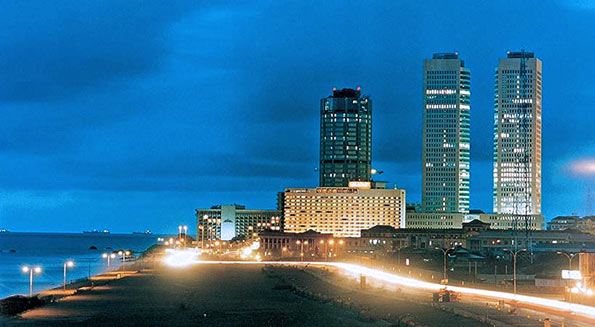Why Sri Lanka’s economic outlook is looking less rosy – report

Sri Lanka’s deal with the International Monetary Fund (IMF) may have averted a crisis, but the bailout may undermine a key source of strength: the country’s impressive economic growth rate.
The deeply indebted country inked an agreement for a $1.5 billion bailout, announced Friday, as it faced heavy fund outflows and overseas debt payments amid declining foreign-exchange reserves, which could have caused a balance of payments crisis.
Foreign-exchange reserves fell by a third from late 2014 to $6.2 billion at the end of March, Reuters reported. Meanwhile, credit rating company Moody’s Investors Service, in a report last week before the IMF deal, noted that general government debt was around 76 percent of gross domestic product (GDP) in 2015, up 71.6 percent from five years earlier.
“Without an IMF loan, Sri Lanka would have been in a precarious position,” Krystal Tan, an Asia economist at Capital Economics, said in a note Saturday, noting that foreign exchange reserves only covered around 80 percent of short-term external debt.
She estimated the bailout would boost reserves to around 108 percent of short-term debt, a bit above the minimum of 100 percent recommended by many economists.
But the deal is likely to come with costs.
“Growth is likely to slow further over the next couple of years,” Tan said. She forecasts the economy will grow at just 4.5 percent this year and next, compared with an average of 6.4 percent between 2010-15.
Despite its financial wobbles, economic growth in Sri Lanka has been impressive in recent years.
Fitch Ratings, which rates Sri Lanka at B+, noted in February that median growth for ‘B’ and ‘BB’ rated countries is around 4.6% and 3.9% respectively.
But the country’s economy may lose a key support.
“While the IMF deal should prevent a crisis in the short-term, policy will need to be tightened to ensure Sri Lanka does not find itself in the same mess again,” Tan said, noting the agreement is contingent on plans to narrow the fiscal deficit.
That’s no small feat: Sri Lanka has now pledged to cut its fiscal deficit to 3.5 percent of GDP from 7.4 percent of GDP in 2015, which itself was well above a 4.4 percent target, and up from 2014’s 5.7 percent, Tan noted.
In a March note, Standard & Poor’s said that government investment was a key factor underpinning economic growth; it affirmed Sri Lanka’s B+ rating, but cut the outlook to negative from stable. At the time, S&P said it expected real per capital GDP growth of 5.5 percent over 2016-19, which it estimated was equivalent to 6.2 percent real GDP growth.
Others have cautioned that Sri Lanka’s government may not be able to spend to boost the economy.
“Interest payments consume nearly a third of government revenues,” Moody’s noted. “More than 40 percent of government debt is denominated in foreign currency. This exposes the government to a larger repayment burden in the event of a depreciation in the local currency, as happened in late 2015.”
While the government is aiming to raise its low revenue collection, partly through an increase in the value-added tax rate, both Moody’s and Tan noted that the country has a spotty record on tax collection.
The private sector may not be able to step up to bolster the economy.
For one, banks are already facing headaches and may not be able to boost credit growth: Moody’s estimates around 4.6 percent of gross loans are problem loans.
The country’s state-owned enterprises are also sitting on a lot of debt, potentially more than $15 billion of liabilities that the government may become responsible for, according to Moody’s data. Some state-owned companies, such as SriLankan Airlines, have been running operating losses for years, said Moody’s, which currently has a B1 rating with a stable outlook on the country’s debt.
In a separate report published in mid-April, the rating agency highlighted another risk to the economy: The prolonged sharp drop in oil prices may hurt remittances from overseas workers in oil-producing Gulf Cooperation Council (GCC) countries. Remittances to Sri Lanka, more than 50 percent of which came from GCC countries, account for around 9 percent of GDP, Moody’s noted.
Last year, remittances to Sri Lanka fell after growing solidly from 2011-2014, the report noted.
In late February, Fitch Ratings downgraded Sri Lanka’s issuer default ratings (IDRs) to B+ from BB- with a negative outlook, citing increasing refinancing risks, significant debt maturities, a decline in foreign exchange reserves and weaker public finances, CNBC reports.

Latest Headlines in Sri Lanka
- Batalanda commission report tabled in Sri Lankan Parliament March 14, 2025
- Female Grama Niladharis withdraw from night duty over security concerns March 14, 2025
- Sri Lanka ranked as the best country for settling down March 14, 2025
- UN pledges support for Sri Lanka’s industrial and SME development March 13, 2025
- Former Boossa Prison Superintendent shot dead in Akmeemana March 13, 2025


